Application Note 062
IEEE 1284 – Updating the PC Parallel Port
Heidi Frock
Most personal computers today are equipped with a parallel port, commonly used to connect the computer to a
parallel printer. Because it is available on most personal computers, the parallel port is a perfect choice for
connection to other peripheral devices. However, communication to peripherals across the parallel port is limited
because the interface is traditionally unidirectional and there is no standard specification for the interface.
Additionally, although the performance of the PC has dramatically increased, the parallel port has remained the
same. This situation has led to the development of a new parallel port standard – IEEE Standard 1284-1994. This
standard is based on the original Centronics Standard Parallel Port (SPP) specification, and includes the Enhanced
Parallel Port (EPP) and Extended Capabilities Port (ECP).
This document describes SPP, EPP, and ECP, as defined by IEEE 1284.
The Standard Parallel Port – the Centronics Parallel Port
The Standard Parallel Port (SPP) is also known as the Centronics parallel port. Centronics Data Computer
Corporation developed the interface in the mid-1960s to be an 8-bit unidirectional parallel host-to-printer
connection. The interface became widely used; however, no industry-standard specification was developed to
define the interface.
The Centronics "standard" defines a 36-pin champ connector and interface signals for the printer side of the
connection. The host side implementation varied widely until the introduction of the IBM PC in 1981. The host
parallel port implementation used on the IBM PC, also referred to as the PC parallel interface, became the de facto
industry PC parallel port interface. The PC parallel interface defines a 25-pin DSub connector with 8 unidirectional
data lines, four control lines, and five status lines. A description of these signals is in Table 1.
Because there is no written standard, the timing relationships between the handshaking signals vary widely among
printers from different manufacturers, even though they may all claim Centronics compatibility. This document will
focus on the IBM PC parallel interface timing, the most common in the industry.
________________________________
Product and company names are trademarks or trade names of their respective companies.
340897A-01
© Copyright 1995 National Instruments Corporation. All rights reserved.
October 1995
�
Table 1. The IEEE 1284 Signal Line Descriptions
SPP Signal Name
EPP Signal Name
ECP Signal Name
Source
Connector
Pinout
Data8-1
Unidirectional data lines. Data8
is the most significant.
STROBE*
Data is valid during an active
low pulse on this line.
AD8-1
Bi-directional address and data
lines. AD8 is the most
significant.
WRITE*
This signal is low during a write
operation and high during a read
operation.
AUTOFD*
Usage of this line varies. Most
printers will perform a line feed
after each carriage return when
this line is low, and carriage
returns only when this line is
high.
INIT*
This line is held low for a
minimum of 50 µs to reset the
printer and clear the print buffer.
SelectIn*
The host drives this line low to
select the peripheral.
ACK*
The peripheral pulses this line
low when it has received the
previous data and is ready to
receive more data. The rising
edge of ACK* can be enabled to
interrupt the host.
BUSY
The peripheral drives this signal
high to indicate that it is not
ready to receive data.
DSTROBE*
This signal denotes data cycles.
During a write operation, data is
valid when this signal is active.
During a read operation, this
signal is low when the host is
ready to receive data.
INIT*
This line is driven low to
terminate EPP mode and return
to SPP mode.
ASTROBE*
This line denotes address cycles.
When this signal is low, AD8-1
is an address.
INTR*
The peripheral can enable this
signal to interrupt the host on the
low to high transition.
WAIT*
The peripheral drives this signal
low to acknowledge that it has
successfully completed the data
or address transfer initiated by
the host.
PError
Usage of this line varies.
Printers typically drive this
signal high during a paper empty
condition.
Select
The peripheral drives this signal
high when it is selected and
ready for data transfer.
FAULT*
Usage of this line varies.
Peripherals usually drive this
line low when an error condition
exists.
User Defined
User Defined
User Defined
Data8-1
Bi-directional address and data
lines. Data8 is the most
significant.
HostClk
This forward direction
handshaking line is interlocked
with PeriphAck and driven low
when data is valid.
HostAck
In the forward direction, this line
is driven low for a command
transfer, and high for a data
transfer. In the reverse direction,
this signal is a handshaking line
interlocked with PeriphClk.
ReverseRequest*
This line is driven low to place the
parallel port interface in the
reverse direction.
1284 Active
The host drives this line high
while in ECP mode, and low to
terminate ECP mode.
PeriphClk
The peripheral drives this reverse
direction handshaking line low to
indicate that the data is valid.
PeriphClk is interlocked with
HostAck.
PeriphAck
This forward direction
handshaking line is interlocked
with HostClk and driven by the
peripheral to acknowledge data
received from the host. During
reverse direction transfers, the
peripheral drives this line high
during data transfers and low
during command transfers.
AckReverse*
The peripheral drives this line to
follow the level of the
ReverseRequest* line.
XFlag
The peripheral drives this line
high to indicate that it uses ECP
mode.
PeriphRequest*
The peripheral drives this signal
low to request a reverse transfer.
This line can be used to interrupt
the host.
Host/
Peripheral
1284-A: 9 - 2
1284-B: 9 - 2
1284-C: 13 - 6
Host
Host
Host
Host
1284-A: 1
1284-B: 1
1284-C: 15
1284-A: 14
1284-B: 14
1284-C: 17
1284-A: 16
1284-B: 31
1284-C: 14
1284-A: 17
1284-B: 36
1284-C: 16
Peripheral 1284-A: 10
1284-B: 10
1284-C: 3
Peripheral 1284-A: 11
1284-B: 11
1284-C: 1
Peripheral 1284-A: 12
1284-B: 12
1284-C: 5
Peripheral 1284-A: 13
1284-B: 13
1284-C: 2
Peripheral 1284-A: 15
1284-B: 32
1284-C: 4
2
�
Figure 1. SPP Data Transfer Timing
The basic SPP data transfer is shown in Figure 1. When the printer is ready to receive data, it drives BUSY low.
The host drives valid data on the data lines, waits a minimum of 500 ns, then pulses STROBE* for a minimum of
500 ns. Valid data must remain on the data lines for a minimum of 500 ns after the rising edge of STROBE*. The
printer will receive the data and drive BUSY active to indicate that it is processing the data. When the printer has
completed the data transfer, it will pulse the ACK* line active for a minimum of 500 ns and de-assert BUSY,
indicating it is ready for the next data byte.
The SPP defines three registers to manipulate the parallel port data and control lines and read the parallel port status
lines. These registers and the corresponding offset to the parallel port starting address are shown in Table 2.
Table 2. SPP Registers
Register
Offset
Data Register
Status Register
Control Register
0
1
2
7
D7
6
D6
5
D5
4
D4
3
D3
2
D2
1
D1
0
D0
BUSY*
ACK*
PError
Select
FAULT*
IRQ*
Reserved Reserved
Reserved Reserved Reserved
IRQEN
SelectIn
INIT*
AUTOFD STROBE
The host computer software must execute four steps to perform one data byte transfer across the parallel port:
1. Write valid data to the data register
2. Poll the BUSY line - wait for it to be inactive
3. Write to the control register to drive STROBE active
4. Write to the control register to de-assert the STROBE signal
The minimum setup, hold and pulse width times required by SPP data transfers greatly limits performance. Taking
into account software latency times, the maximum possible transfer rates are 150 kbytes/s. Typical transfer rates are
around 10 kbytes/s.
3
�
Many file transfer programs overcome the unidirectional limitation of the PC parallel port by using four of the status
lines (SLCT, BUSY, PE, ERROR) to send data to the host four bits at a time. The ACK line can be used to interrupt
the host to indicate that data is ready to be read.
The Bidirectional Port
The IBM PS/2 computer enhanced the standard PC parallel interface by adding bidirectional drivers to the eight data
lines. The I/O connector and signal assignments remained the same. A parallel port with bidirectional drivers is
often referred to as an extended mode parallel port. IBM refers to a bidirectional port as a Type 1 parallel port.
IBM also defines Type 2 and Type 3 parallel ports which use a DMA channel to write/read blocks of data to/from
the parallel port. The parallel port on most computers is configured at the factory to operate as an unidirectional
parallel port. A setup utility specifically for the system must be used to select bidirectional operation.
The Register map for an IBM PS/2 parallel port is shown in Table 3. An extended mode (Type 1) parallel port has
only the first three registers. These registers are identical to the SPP register set with an additional Direction bit in
the parallel port control register. The last three registers in Table 3 are only present in Type 2 and 3 parallel ports.
Type 2 and 3 DMA transfers follow the SPP timing as described earlier. During Type 2 or 3 DMA writes, the DMA
controller writes data to the data register and a STROBE pulse is automatically sent. When the ACK is received
from the peripheral, a DMA request is sent and the next byte is then transferred. The peripheral can drive BUSY to
hold off the transfer. During Type 2 or 3 DMA reads, a pulse on the ACK line generates a DMA request and
initiates the transfer to system memory. The DMA controller reads the data register and a STROBE pulse is
automatically generated.
Although IBM defined Type 2 and 3 parallel ports to increase parallel port performance, only IBM computers
implement the ports. Thus, there is a lack of software that takes advantage of the DMA feature. By comparison,
EPP and ECP are industry standards supported by a wide variety of hardware and software manufacturers.
Table 3. Bidirectional Port Registers
Register
Offset
Data Register
Status Register
Control Register
Interface Control
Register
Interface Status
Register
Reserved
Register
0
1
2
3
4
5
7
D7
6
D6
5
D5
4
D4
3
D3
2
D2
1
D1
0
D0
BUSY*
ACK*
PError
Select
FAULT*
IRQ*
Reserved Reserved
Auto
Strobe
Start
DMA
Reserved
Reserved Direction
IRQEN
SelectIn
INIT*
AUTOFD STROBE
Reset
EOD
EOD
TC/ACK
IRQEN
TC/ACK
INT
Select
IRQEN
Select
INT
FAULT
IRQEN
FAULT
INT
PError
IRQEN
PError
INT
Set EOD DMAEN
Reserved Reserved
Reserved Reserved Reserved Reserved Reserved Reserved Reserved Reserved
Enhanced Parallel Port – EPP
EPP was developed to provide for high-speed, bidirectional data transfers that are compatible with the register map
of the existing standard parallel port. The EPP specification assigns traditional microprocessor bus signaling
functions to the standard parallel port lines (i.e. address strobe, data strobe) to access adapter hardware directly.
See Table 1 for a description of these parallel port signals.
A data transfer on a standard parallel port requires several software steps. EPP adds additional hardware and
registers to automatically generate control strobes and data transfer handshaking with a single I/O instruction. With
4
�
an ISA machine, maximum possible transfer rates are 2 Mbytes/s. Transfer rates up to 10 Mbytes/s can be achieved
on other platforms.
EPP operations are typically two-phase bus cycles initiated by the host. The host first selects a register within the
peripheral and performs an address cycle. Then the host performs a series of read and/or writes to that selected
register. EPP defines a single interrupt request signal, INTR, enabling the peripheral with a means to signal the host.
EPP has four basic operations – address write, address read, data write, and data read.
An EPP Address Write cycle is shown in Figure 2. The host first asserts WRITE*, places the address byte on the
AD8-1 lines, and asserts ASTROBE*. The peripheral de-asserts WAIT* indicating that it is ready for the address
byte. The host then de-asserts ASTROBE* and the peripheral latches the address lines on the rising edge of
ASTROBE*. The peripheral then indicates that it is ready for the next cycle by asserting WAIT*.
Figure 2. EPP Address Write Cycle
An EPP Address Read cycle is shown in Figure 3. The host de-asserts WRITE*, places the AD7-0 lines in a high
impedance state, and asserts the ASTROBE* signal. The peripheral then drives the address byte on the AD7-0 lines
and re-asserts WAIT* to indicate that the address byte is valid. The host will read the address lines when it sees the
WAIT* unasserted, and then de-asserts ASTROBE. The peripheral then places the AD8-1 lines in an high
impedance state and asserts WAIT* to indicate it is ready for the next cycle.
Figure 3. EPP Address Read Cycle
An EPP Data Write cycle is shown in Figure 4. The host first asserts WRITE*, places the data byte on the AD8-1
lines, and asserts DSTROBE*. The peripheral de-asserts WAIT* indicating that it is ready for the data byte. The
5
�
host then de-asserts DSTROBE* and the peripheral latches the data lines on the rising edge of DSTROBE*. The
peripheral then indicates that it is ready for the next cycle by asserting WAIT*.
WRITE*
ASTROBE*
DSTROBE*
AD8-1
WAIT*
Data Byte
Figure 4. EPP Data Write Cycle
An EPP Data Read cycle is shown in Figure 5. The host de-asserts WRITE*, places the AD8-1 lines in a high
impedance state, and asserts the DSTROBE* signal. The peripheral then drives the data byte on the AD8-1 lines
and re-asserts WAIT* to indicate that the data byte is valid. The host will read the data lines when it sees the
WAIT* unasserted, and then de-asserts DSTROBE*. The peripheral then places the AD8-1 lines in an high
impedance state and asserts WAIT* to indicate it is ready for the next cycle.
WRITE*
ASTROBE*
DSTROBE*
AD8-1
WAIT*
Data Byte
Figure 5. EPP Data Read Cycle
EPP defines five parallel port registers in addition to the three registers of the standard parallel port. These registers
are used to automatically place the address or data information on the parallel port data lines and then generate the
address strobe and data strobe signals automatically. The parallel port register set for EPP is shown in Table 4. The
parallel port data register, status register, and control register have the same bit assignments as described for
standard parallel ports.
Data written to the Auto Address Strobe register is placed on the parallel port data lines followed by an automatic
active low pulse on the ASTROBE* line. Data written to any of the Auto Data Strobe registers is placed on the
parallel port data lines followed by an automatic active low pulse on the DSTROBE* line. When one of the Auto
Data Strobe registers is read, the DSTROBE* line is pulsed and the value on the parallel port data lines is returned.
The microprocessor bus architecture of the EPP standard makes it ideal for communicating directly to peripheral
hardware; it acts like a mini-expansion port aimed at accessing intelligent peripherals which are controlled with
register accesses.
6
�
Table 4. EPP Mode Parallel Port Register Map
Register
Read or Write
Register Offset
Parallel Port Data Register
Parallel Port Status Register
Parallel Port Control Register
Auto Address Strobe Register
Auto Data Strobe Register
Auto Data Strobe Register
Auto Data Strobe Register
Auto Data Strobe Register
Write
Read
Read/Write
Read/Write
Read/Write
Read/Write
Read/Write
Read/Write
0
1
2
3
4
5
6
7
Extended Capabilities Port – ECP
ECP is an extension to the standard parallel port developed by Microsoft and Hewlett Packard. The specification
defines automatic hardware handshaking, command and data cycles, and DMA transfers to a FIFO location. The
handshaking signals for data transfers have the same timing relationships as defined for standard parallel ports.
Table 1 shows the parallel port signal line descriptions for an ECP parallel port. ECP claims maximum transfer
rates of 2.4 Mbytes/s when performing DMA transfers on an ISA computer.
ECP defines data transfers from the host computer to the peripheral as forward transfers. Figure 6 shows an ECP
forward transfer. In the forward direction, the host will drive HostClk low when data is available on the parallel port
lines, and the peripheral will drive PeriphAck high after it accepts the data.
ReverseRequest*
D8-1
HostClk
PeriphAck
Figure 6. ECP Forward Transfer
7
�
Data transfers from the peripheral to the host computer are called reverse transfers. Figure 7 shows an ECP reverse
direction transfer. In the reverse direction, the peripheral will drive PeriphClk low when data is available on the
parallel port lines, and the host will drive HostAck low after it has accepted the data.
ReverseRequest*
AckReverse*
D8-1
PeriphClk
HostAck
Figure 7. ECP Reverse Transfer
8
�
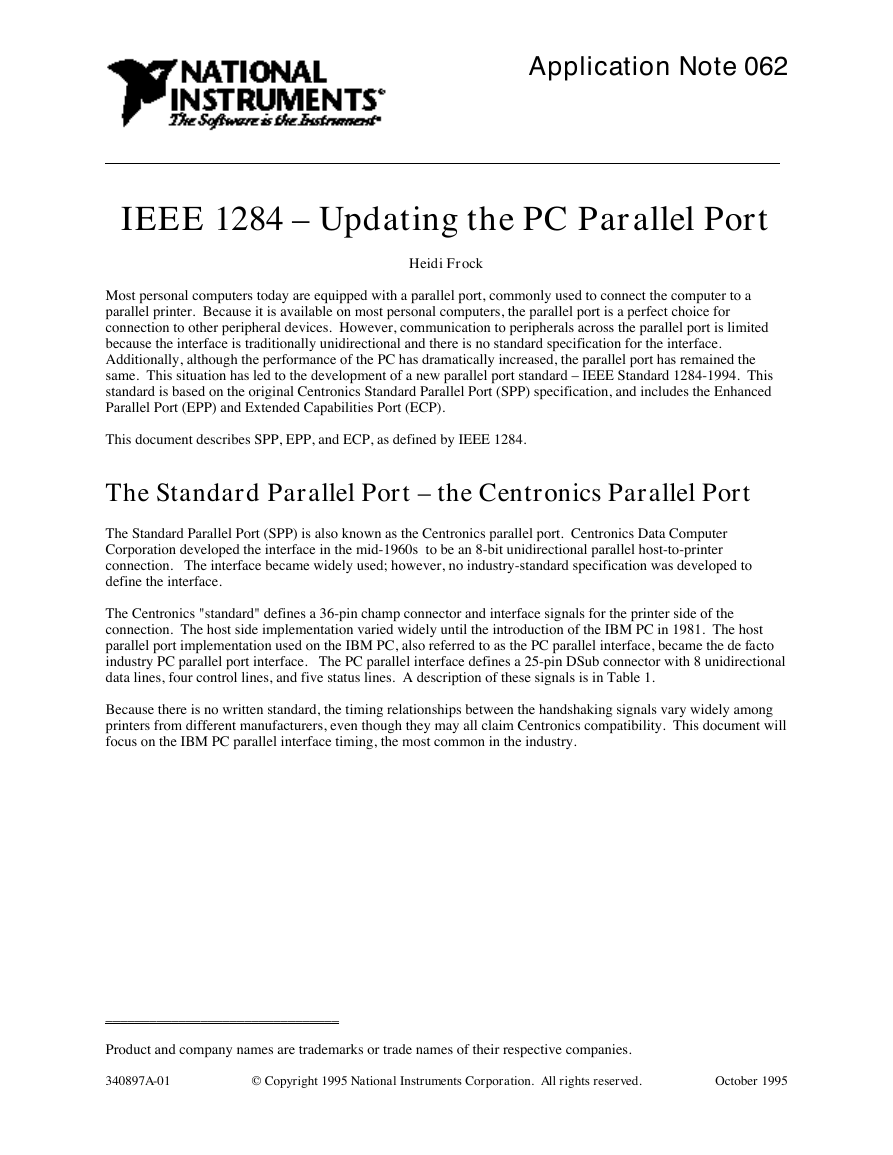

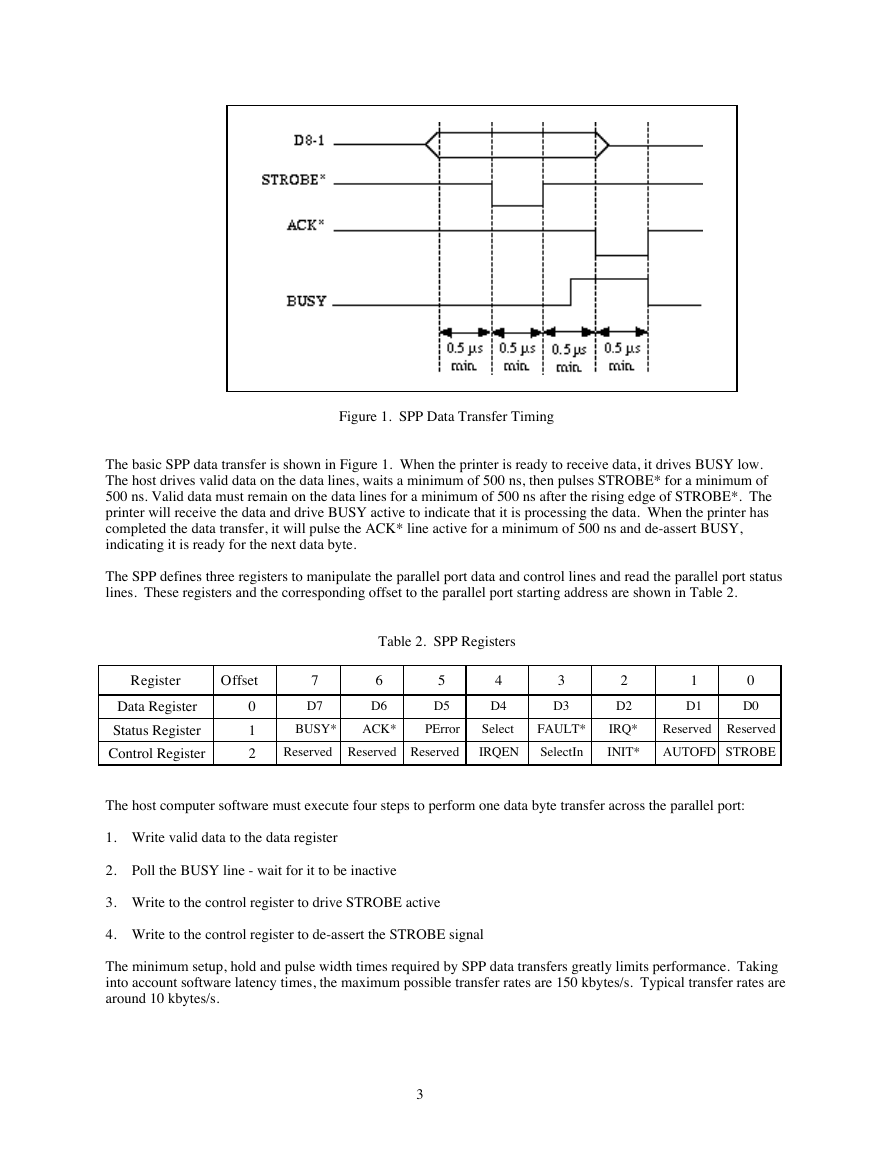

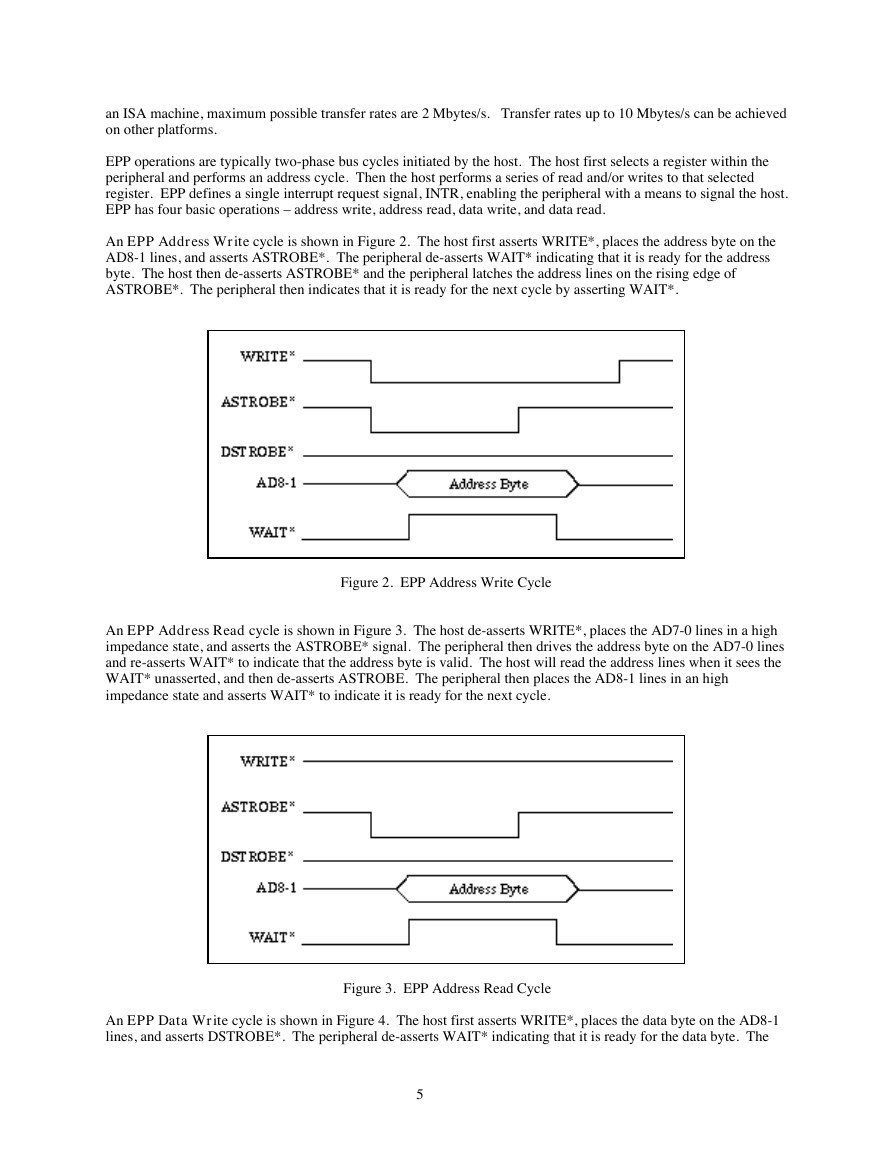
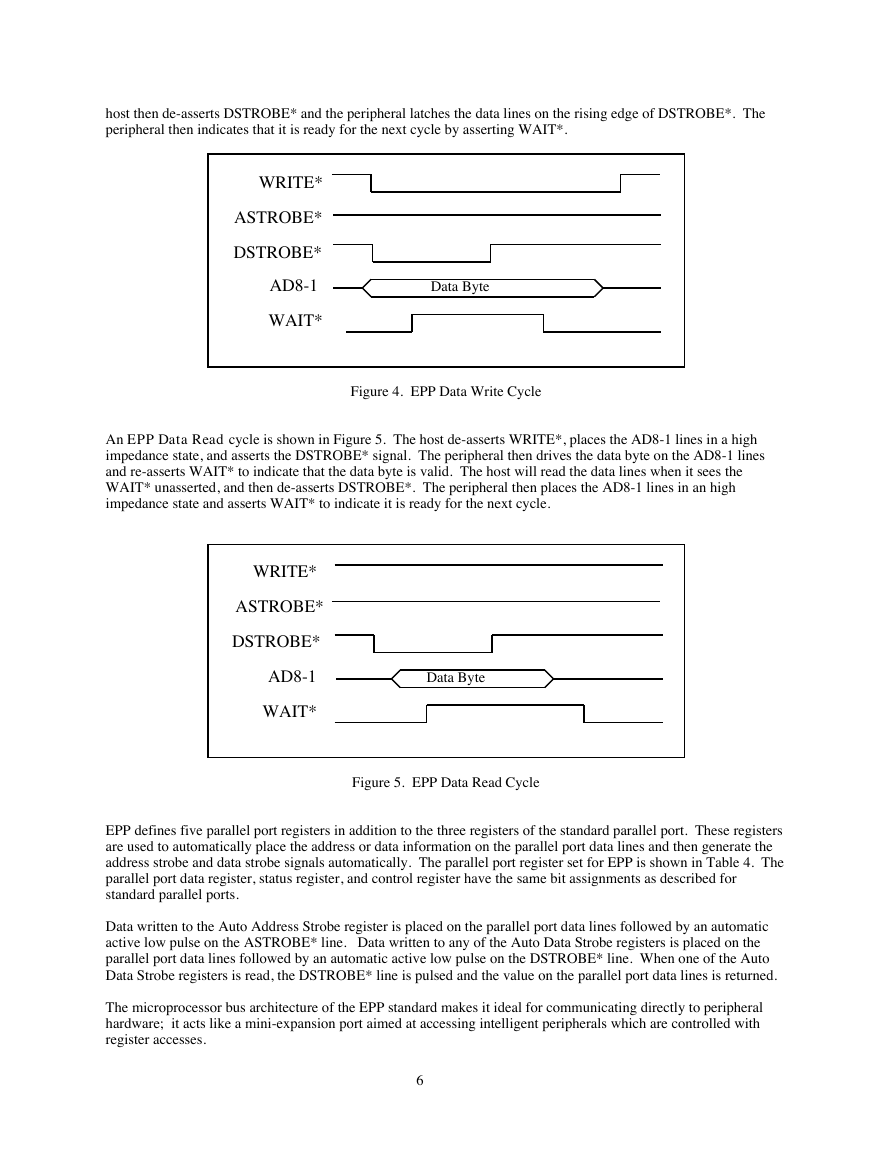
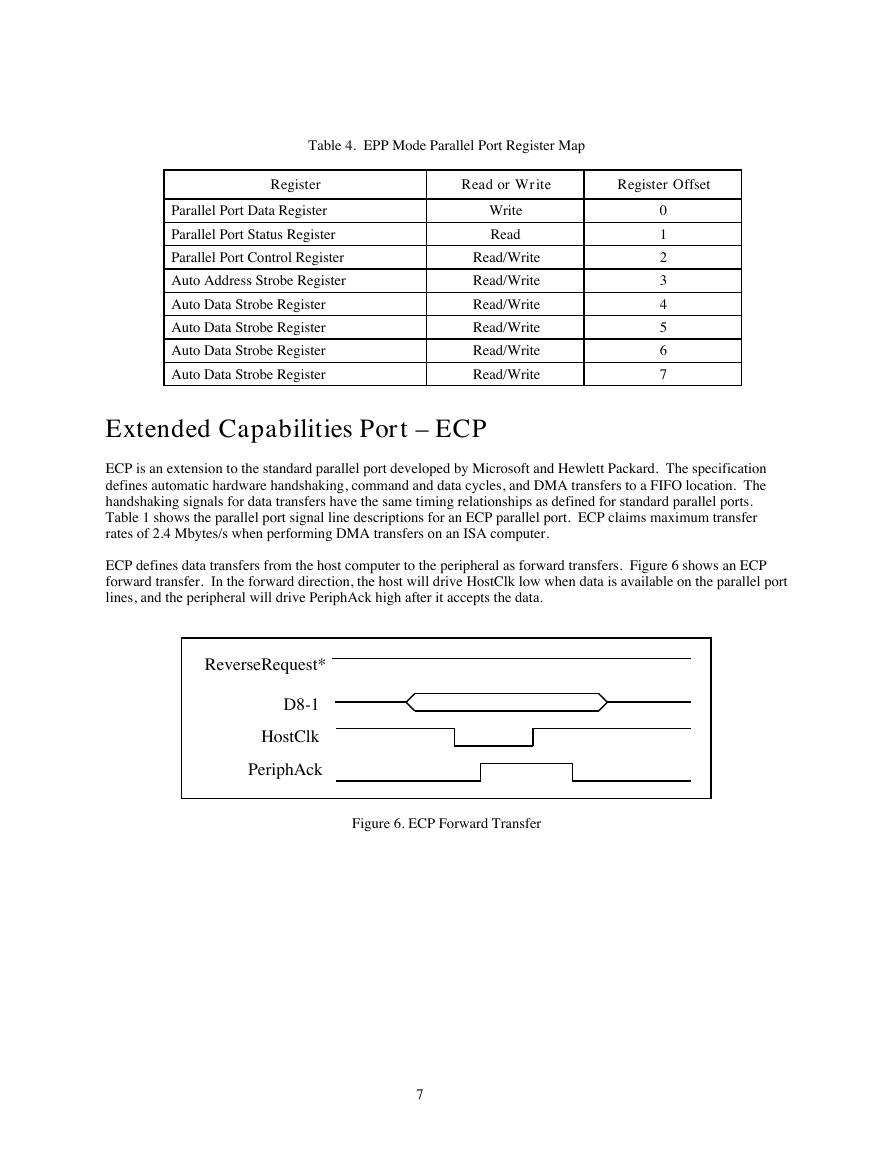
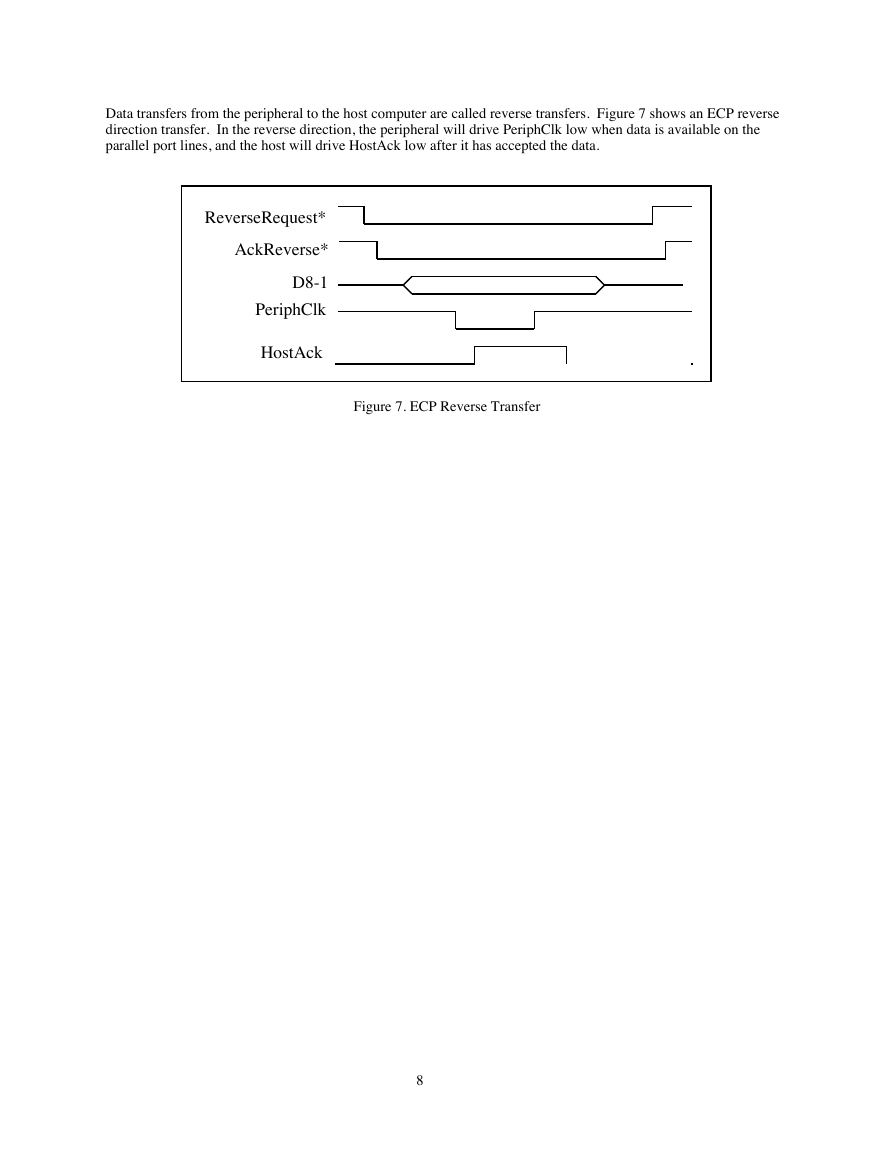








 2023年江西萍乡中考道德与法治真题及答案.doc
2023年江西萍乡中考道德与法治真题及答案.doc 2012年重庆南川中考生物真题及答案.doc
2012年重庆南川中考生物真题及答案.doc 2013年江西师范大学地理学综合及文艺理论基础考研真题.doc
2013年江西师范大学地理学综合及文艺理论基础考研真题.doc 2020年四川甘孜小升初语文真题及答案I卷.doc
2020年四川甘孜小升初语文真题及答案I卷.doc 2020年注册岩土工程师专业基础考试真题及答案.doc
2020年注册岩土工程师专业基础考试真题及答案.doc 2023-2024学年福建省厦门市九年级上学期数学月考试题及答案.doc
2023-2024学年福建省厦门市九年级上学期数学月考试题及答案.doc 2021-2022学年辽宁省沈阳市大东区九年级上学期语文期末试题及答案.doc
2021-2022学年辽宁省沈阳市大东区九年级上学期语文期末试题及答案.doc 2022-2023学年北京东城区初三第一学期物理期末试卷及答案.doc
2022-2023学年北京东城区初三第一学期物理期末试卷及答案.doc 2018上半年江西教师资格初中地理学科知识与教学能力真题及答案.doc
2018上半年江西教师资格初中地理学科知识与教学能力真题及答案.doc 2012年河北国家公务员申论考试真题及答案-省级.doc
2012年河北国家公务员申论考试真题及答案-省级.doc 2020-2021学年江苏省扬州市江都区邵樊片九年级上学期数学第一次质量检测试题及答案.doc
2020-2021学年江苏省扬州市江都区邵樊片九年级上学期数学第一次质量检测试题及答案.doc 2022下半年黑龙江教师资格证中学综合素质真题及答案.doc
2022下半年黑龙江教师资格证中学综合素质真题及答案.doc